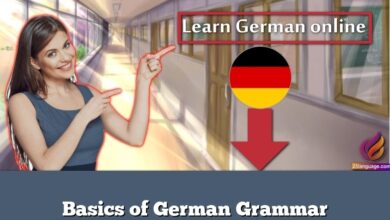German Verb Conjugations: A Step-by-Step Guide

German Verb Conjugations: A Step-by-Step Guide.Understanding and mastering German verb conjugations can be a challenging but rewarding aspect of learning the language. Here’s a step-by-step guide to help you get started, including translations to English.
1. Identify the Verb Stem
The stem of a verb is its basic form, minus any endings. For example, in the verb “spielen” (to play), the stem is “spiel-“.
2. Regular vs. Irregular Verbs
German has both regular and irregular verbs. Regular verbs follow a predictable pattern in their conjugations, while irregular verbs do not and must be memorized.
3. Conjugating Regular Verbs
For regular verbs, you add specific endings to the stem based on the subject. Here’s an example using “spielen”:
- Ich spiele (I play)
- Du spielst (You play, informal singular)
- Er/Sie/Es spielt (He/She/It plays)
- Wir spielen (We play)
- Ihr spielt (You play, informal plural)
- Sie spielen (They play / You play, formal)
4. Conjugating Irregular Verbs
Irregular verbs may change the stem vowel in their conjugations. For example, “sprechen” (to speak):
- Ich spreche (I speak)
- Du sprichst (You speak, informal singular)
- Er/Sie/Es spricht (He/She/It speaks)
- Wir sprechen (We speak)
- Ihr sprecht (You speak, informal plural)
- Sie sprechen (They speak / You speak, formal)
5. Tenses
German verbs are conjugated in different tenses to indicate time. The most commonly used tenses are Present, Past (Präteritum), and Perfect.
6. The Past Participle
For the Perfect tense, you’ll need the past participle of the verb, which often ends in “-t” for regular verbs (e.g., “gespielt” for “spielen”) and varies for irregular verbs (e.g., “gesprochen” for “sprechen”).
7. Auxiliary Verbs
In some tenses, like the Perfect, you also need an auxiliary verb (“haben” or “sein”) to form the correct conjugation.
8. Practice and Context
Practice conjugating verbs in different tenses and using them in sentences. Contextual usage helps in understanding the nuances of verb conjugations.
9. Resources
There are many resources available for learning German verbs, including textbooks, online courses, and language learning apps. Regular practice and exposure to the language are key.
By following these steps and consistently practicing, you’ll gradually become more comfortable with German verb conjugations. Remember, language learning is a journey, so be patient and enjoy the process!
Example
Certainly! Here’s an example of German verb conjugations for the verb “lernen” (to learn) in the present tense, presented in a table format with English translations:
| German Pronoun | Verb Conjugation | English Translation |
|---|---|---|
| Ich | lerne | I learn |
| Du | lernst | You learn (informal singular) |
| Er/Sie/Es | lernt | He/She/It learns |
| Wir | lernen | We learn |
| Ihr | lernt | You learn (informal plural) |
| Sie | lernen | They learn / You learn (formal) |
This table demonstrates how the verb “lernen” is conjugated for each pronoun in the present tense, providing a clear example of a regular verb conjugation pattern in
Phrases
Certainly! Below is a table featuring phrases using the verb “gehen” (to go) in the present tense, along with their English translations. This will give you a practical sense of how German verb conjugations are used in context.
| German Pronoun | Verb Conjugation | German Phrase | English Translation |
|---|---|---|---|
| Ich | gehe | Ich gehe zum Markt. | I go to the market. |
| Du | gehst | Du gehst zur Schule. | You go to school. (informal singular) |
| Er | geht | Er geht ins Kino. | He goes to the cinema. |
| Sie | geht | Sie geht in den Park. | She goes to the park. |
| Es | geht | Es geht ihm gut. | It is going well for him. |
| Wir | gehen | Wir gehen einkaufen. | We are going shopping. |
| Ihr | geht | Ihr geht spazieren. | You go for a walk. (informal plural) |
| Sie | gehen | Sie gehen ins Theater. | They go to the theater. / You go to the theater. (formal) |
This table illustrates how the verb “gehen” changes depending on the subject of the sentence, providing useful examples of its use in everyday phrases.





























